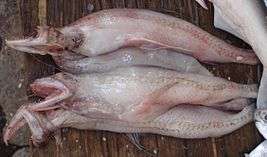Bombay duck
| Bombay duck | |
|---|---|
.jpg) | |
| Scientific classification | |
| Kingdom: | Animalia |
| Phylum: | Chordata |
| Class: | Actinopterygii |
| Order: | Aulopiformes |
| Family: | Synodontidae |
| Genus: | Harpadon |
| Species: | H. nehereus |
| Binomial name | |
| Harpadon nehereus (F. Hamilton, 1822) | |

The Bombay duck or bummalo, Harpadon nehereus, (Bengali: bamaloh or loytta, Marathi: bombil, Sinhala: bombeli, Urdu: بمبل مچھلی) is, despite its name, not a duck but a lizardfish. Adults may reach a maximum length of 40 cm, but the usual size is around 25 cm.[1]
Distribution and fisheries

The Bombay duck lives in the tropical areas of the Indo-Pacific. It has been traditionally caught in the waters off Maharashtra in the Lakshadweep Sea, where it is an important item of the yearly catch. This fish is also caught in the Bay of Bengal and in the South China Sea, although in smaller numbers.[2]
The fish is often dried and salted before it is consumed, as its meat does not have a distinctive taste of its own. After drying, the odour of the fish is extremely powerful, and it is usually transported in air-tight containers. The Bombay duck is a popular food item in certain areas of India. Fresh fish are usually fried and served as a starter. In Mumbai, Konkan, and the western coastal areas in India, this dish is popularly known as "Bombil fry".
Etymology
The origin of the term "Bombay duck" is uncertain. One popular etymology relates to railways. When the rail links started on the Indian subcontinent, people from eastern Bengal were made aware of the great availability of the locally prized fish on India's western coasts and began importing them by the railways. Since the smell of the dried fish was overpowering, its transportation was later consigned to the mail train; the Bombay Mail (or Bombay Daak) thus reeked of the fish smell and "You smell like the Bombay Daak" was a common term in use in the days of the British Raj. In Bombay, the local English speakers then called it so, but it was eventually corrupted into "Bombay duck". Nonetheless, the Oxford English Dictionary dates "Bombay duck" to at least 1850, two years before the first railroad in Bombay was constructed, making this explanation unlikely.[3][4]
According to local Bangladeshi stories, the term Bombay duck was first coined by Robert Clive, after he tasted a piece during his conquest of Bengal. It is said that he associated the pungent smell with that of the newspapers and mail which would come into the cantonments from Bombay. The term was later popularized among the British public by its appearance in Indian restaurants in the UK.
In his 1829 book of poems and "Indian reminiscences", Sir Toby Rendrag (pseudonym) notes the "use of a fish nick-named 'Bombay Duck'"[5] and the phrase is used in texts as early as 1815.[6]
European Union import restrictions
In 1997, Bombay duck was banned by the European Commission (EC). This was because the EC prohibited fish imports from India other than from approved freezing and canning factories, and Bombay duck is not produced in a factory.
According to the "Save Bombay Duck" campaign,[7] the Indian High Commission approached the European Commission about the ban and the EC adjusted its regulations so that the fish can still be dried in the open air, but has to be packed in an "EC approved" packing station. A Birmingham wholesale merchant located a packing source in Mumbai, and the product became available again in the United Kingdom. Before the ban, consumption in the United Kingdom was over 13 tonnes per year.
Bombay duck is available fresh in Canada in cities with large Indian populations, such as Toronto and Montreal, and is generally known as bumla. Although mainly popular with Indians from Bengal, southern Gujarat, coastal Maharashtra, Goa, and Karnataka, it is increasingly consumed by the other South Asian populations, Bangladeshis in particular.
References
- ↑ FishBase - Harpadon nehereus
- ↑ "Harpadon nehereus". Integrated Taxonomic Information System. Retrieved 18 April 2006.
- ↑ duck, n.1. Oxford English Dictionary, 2nd ed., 1989; online version December 2011. Accessed 2 February 2012.
- ↑ IR History: Early Days - I. Indian Railways Fan Club website. Accessed 2 February 2012.
- ↑ Toby Rendrag (sir, pseud.), Poems, original, lyrical, and satirical, containing Indian reminiscences of the late sir Toby Rendrag, Publ. 1829 W. Boyls page 26
- ↑ A. Clark, William Combe, Paddy Hew: a poem : from the brain of Timothy Tarpaulin, Printed for Whittingham and Arliss, 1815, 195 pages, page 86
- ↑ "Save Bombay Duck". Bombay-duck.co.uk. 2003-12-16. Retrieved 2009-07-25.
External links
 Media related to Harpadon nehereus at Wikimedia Commons
Media related to Harpadon nehereus at Wikimedia Commons